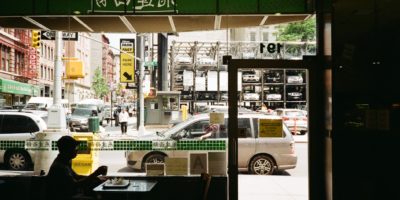A Complete Guide to the Buttes Chaumont Park in Paris
Paris’s Parc des Buttes-Chaumont (coming from a combination of the words “chauve” and “mont”—in english, “bald hill”) is one of the most beautiful parks in the city. It offers a commanding view, lush grass perfect for a nap or a picnic on a warm day, and of course, like most other places in the city, it’s a gold mine for people watching. If you want to photobomb a bride and groom, or just watch them being cute (don’t be creepy!), this is your place.
This is one of my favorite parks in Paris because of its situation on the relative outskirts of the city. Other famous parks, like Luxembourg, le Jardin des Plantes, and Place des Vosges are always lovely on a warm day, but at Buttes Chaumont, you’ll be a bit less overwhelmed by the “foule” (crowd). You definitely won’t have the place to yourself—you’ll have to search long and hard for a place like that in a city like Paris, but you can count on finding your patch where the grass is still lush and green.

Buttes Chaumont in Winter – by author
Each season has its perks in the park—in winter, if you’re lucky enough to experience the snow, you’ll find some great sledding hills in the lower regions of the park (you could hypothetically sled the upper slopes, but skis may be more appropriate—especially considering the cold lake at the bottom. In spring, the cherry blossoms and flower gardens are in full bloom. In summer, you’ll have your picnic blanket/charcuterie/cheese/baguette/wine afternoon while overlooking the city. And fall will bring the standard display of stunningly bright leaves carpeting the grass around the lake.
But it hasn’t always been such a fairy tale.
History
It starts like a medieval horror story: in the eleventh century, the king at the time installed a massive gibbet just east of the present-day park. In use until 1760, these were the largest gallows in France, capable of hanging several dozen miscreants at once as a public exhibition.

The Gibbet of Montfaucon in the Middle Ages – Wiki Commons
Already porting a nasty reputation, the site of the park became a gypsum mine after the revolution. Miners sent this important building material both to Paris and to the united states, but the massive basin excavated in the mining process also served as the neighborhood dump. The decomposing mass wafted its acrid fumes across the neighborhood and the city before finally rotting into fertilizer. But one key ingredient made the odor especially intolerable: the mine was a favorite depository for horse carcasses. With something like 35,000 horses in the city on a given day, their deaths represented a significant problem solved by this giant pit in the ground.

Mines of Buttes Chaumont – Wiki Commons
However, you’d never guess the park’s and neighborhood’s gory history on a visit to the area (one would hope!). In 1852, Napoleon took over the French government to establish the Second Empire. He had a grand vision for the city: during his reign, he worked with Georges-Eugène Haussmann to overhaul the city and give it the face we know today. This included four parks, like compass points for the city: Bois de Boulogne, Parc Montsouris, Bois de Vincennes, and, voilà, Parc des Buttes-Chaumont.
Mining stopped in 1860, and after cleaning out the decomposing horses, construction began in 1863. They used explosives to carve out the buttes we know today, pumped water from the Bassin de la Villette to fill the lake, and finished construction in time for the Exposition Universelle in 1867.
Things to do

Pont Gustave Eiffel, Parc des Buttes Chaumont – by BikerNorman, Wiki Commons
When you visit, be sure to admire the architecture and bounce a little bit on the long suspension bridge leading across the lake. Designed by Gustave Eiffel, it’s the perfect spot for a wedding photo or just a quick selfie. If you need another wedding shot with a great view over the city (it probably won’t be your wedding when you visit, but they’re nice spots all the same) climb the path to the Temple de la Sybille atop the butte.
Architect Gabriel Davioud, who also designed the Fontaine Saint-Michel and many other city monuments of the time, designed this little gazebo-like structure, modeling it after an ancient Roman temple in the hills of Italy.
Now that you’ve reached the peak, descend the stairs (careful of your wedding gown!). Traverse the so called “suicide bridge,” which got its name after local newspapers reported several unfortunate jumps. And after all of that, you’re probably hungry, or maybe you’ve watched the sunset and are looking for a dance party?
Stay calm—you have the choice between three restaurants. In the south-west tip, you have the Pavillon Puebla, a cozy café and restaurant, or the Pavillon du Lac, a fancier-looking establishment in a dignified building situated just east of the lake.
If you’re looking for the most fun, however, and something a little less pricey, I would check out Rosa Bonheur. This café fashions itself as a modern guinguette, a name given to cafés in the suburbs of Paris in the 19th and early 20th centuries. The name comes from their most popular drink at the time—a cheap wine called guinguet—and working Parisians would flock to these wooded establishments on weekends to avoid city alcohol taxes and to dance.

Rosa Bonheur – Evan Bench – Wiki Commons
A guinguette here in Parc des Buttes Chaumont is fitting—the park used to represent the edge of the city. And there’s evidence: near Rosa Bonheur, to the north as you walk down the hill among the grand trees, you’ll see a small canyon with a set of train tracks. This is a piece of Napoleon III’s Voie ferrée de la petite ceinture, the retired beltway around Paris. Parc des Buttes-Chaumont is just one place where you’ll find the graffitied ruins of this relic—you’ll find more bits and pieces along Rue de Ménilmontant and elsewhere.

La Petite Ceinture, Parc des Buttes Chaumont – Wiki Commons
The abandoned tracks add to the outskirts-of-town ambiance, and although the drinks probably aren’t as cheap as they once were, Rosa Bonheur assumes the old roll of guinguette. In addition to tapas and drinks, they host several concerts/DJ nights each month, as well as (often) free community activities. This month, they host a community food coop, buying food directly from producers and serving as a pick-up point for community members; they also have a free clothing repair day, and put on a free neighborhood hair salon. These events are generally free, with a suggested donation.
I hope it’s clear by now that the park has a lot to offer—the only thing missing is YOU! Where else can you go from a stroll in the forest to a sunset picnic to a woodsy dance party without skipping a beat?

La Petite Ceinture, Parc des Buttes Chaumont – by Traktorminze – Wiki Commons
Planning a trip to Paris ? Get ready !
These are Amazon’s best-selling travel products that you may need for coming to Paris.
Bookstore
- The best travel book : Rick Steves – Paris 2023 – Learn more here
- Fodor’s Paris 2024 – Learn more here
Travel Gear
- Venture Pal Lightweight Backpack – Learn more here
- Samsonite Winfield 2 28″ Luggage – Learn more here
- Swig Savvy’s Stainless Steel Insulated Water Bottle – Learn more here
Check Amazon’s best-seller list for the most popular travel accessories. We sometimes read this list just to find out what new travel products people are buying.










